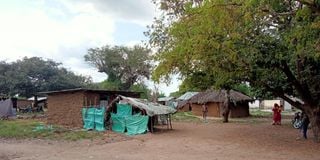Premium
How Lamu fishermen brought life to a sleepy village

A section of Magogoni village in Lamu County.
What you need to know:
- Magogoni village elder, Arafa Lacho Bashora, said that before the name was adopted, the original Kwasasi-Ingini was a place known for having a huge forest with enormous and rare trees
- Magogoni's profile was raised in the 1990s when the government established the Manda-Magogoni Kenya Naval Base, the second in the country after Mtongwe Naval Base in Mombasa County
- Mr Mbwana says that although the fishermen, who were also Bajuni, contributed to the development of Magogoni, the Bajuni farmers remain the pioneers
For decades, Lamu East Subcounty, which encompasses several scattered islands, was considered the fishing hub for the entire Lamu region, contributing about 70 per cent of the county's revenue from the sector.
In recent years, in an effort to move their businesses to Lamu West, groups of fishermen have taken up residence in a remote, sleepy village that is currently home to a Kenyan naval base.
Activities in Magogoni village were boosted in the 1970s by fishermen from the Lamu East Islands who used the area as a crossing point when seeking a market for their catch in Lamu West.
The village got its name from the many logs (magogo in Swahili) scattered around the area.
As there was no bridge for the fishermen to cross from Lamu East to Lamu West after a night's journey across the vast Indian Ocean, they improvised and used the logs to build a bridge.
Such an idea eventually enabled them to transport fish to the other side of the county (Lamu West) to sell their catch before returning to their homes in Lamu East.

A section of Magogoni village in Lamu County.
It was through this improvisation of the logs used by the fishermen as a bridge that the name 'Magogoni' was born and has flourished to this day.
Magogoni village elder, Arafa Lacho Bashora, said that before the name was adopted, the original Kwasasi-Ingini was a place known for having a huge forest with enormous and rare trees.
“The Bajuni and other people like the Boni, who had been displaced from their homes in Kiunga and parts of Boni forest region during the Shifta war of the 1960s, settled at Kwasasi-Ingini and Manda Island. At Kwasasi-Ingini, the Bajuni, who are traditionally known for farming, started cutting down trees and clearing the forest to create farms. This left many logs (Magogo) scattered everywhere here,” said Ms Lacho.
“By then, fishermen in the general Lamu East region were, as well, experiencing a market challenge for their catch. They wanted to sell their fish in large quantities. That only happened in Lamu West.”
She added: "To get to Lamu West, they used their dhows docked at Kwasasi-Ingini. The fishermen then used the idle logs to navigate to the dry land or depot before proceeding to their market places in Lamu Old Town, Mokowe, Hindi, Mpeketoni, and as far as Malindi and Mombasa."
Magogoni's profile was raised in the 1990s when the government established the Manda-Magogoni Kenya Naval Base, the second in the country after Mtongwe Naval Base in Mombasa County.

A section of Magogoni village in Lamu County.
Operating as a Forward Operations Base (FOB), the Kenya Naval Base was established in 1992 and officially inaugurated in 1995 to provide logistical support to Kenya Defence Force (KDF) units stationed in Northern Kenya and Kismayu.
Over the years, the base has grown to include an all-weather airstrip with night landing capability and a 1.3km runway. Since 2004, the base has hosted a US government Forward Operating Location (FOL) under the operational control of the Combined Joint Task Force-Horn of Africa (CJTF - HOA) in Djibouti.
Lamu historian Mohamed Mbwana, who is also the chairman of the Lamu Council of Elders, says the village was founded by Shifta War IDPs, mostly Bajuni, before the fishermen arrived.
Mr Mbwana says that although the fishermen, who were also Bajuni, contributed to the development of Magogoni, the Bajuni farmers remain the pioneers.
“After the Shifta wars displaced the Bajuni from their indigenous homes in Kiunga in July 1964, they fled and settled in Manda Island. Manda had lots of stones that were unfavourable for farming. So, some opted to establish farms in Kwasasi-Ingini, which is in the neighbourhood,” said Mr Mbwana.
"Our forefathers cut down the trees to create farms. This left the place with many logs (Magogo in Swahili) that spread all over. The big python snakes that infested the place also looked like logs. So, there were both tree logs and big snakes that also looked like logs. And that’s how the name Magogoni was adopted to date.”
However, the establishment of the Kenyan naval base resulted in the eviction of some locals.
Today, the Magogoni village and trading centre is about 300 metres from the naval base. At least 400 families from various Kenyan tribes live there.
However, The Nation found out that none of the families own land because they do not have title deeds.
Ali Keah, a resident, appealed to both the county and national governments in coordination with the National Lands Commission (NLC) to survey Magogoni land and ensure that genuine residents receive title deeds.
“We were born and raised here. We have no other place in this country to call home. We will only be okay when the government issues us with title deeds to protect our lands,” said Mr Keah.





